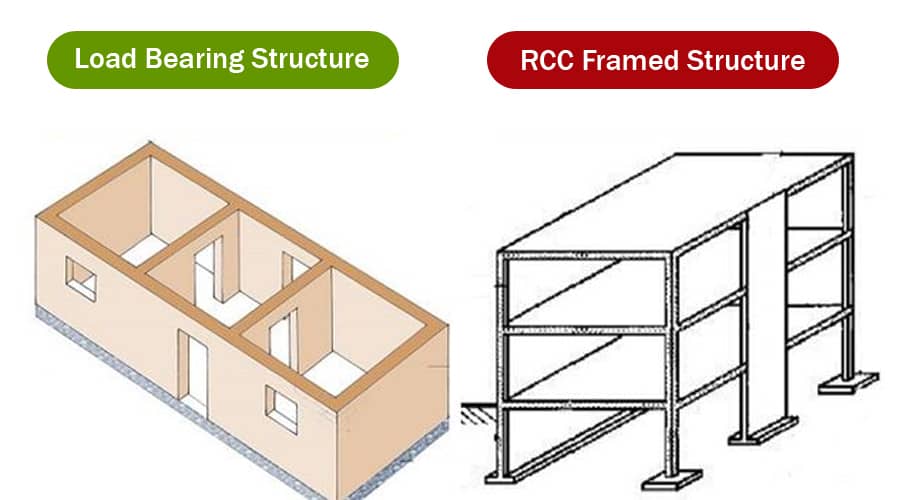Load bearing vs. RCC framed structures

The load-bearing structure and the RCC framed structure systems are the two methods used to construct homes. We will learn the distinctions between load-bearing structures and framed buildings in this post, so let's get started.
Load-bearing structure, one of the earliest types of construction, is also known as wall-bearing structure, whereas RCC frame structure is also known as column beam structure.
Various Differentials aspects
Load Bearing aspect
RCC framed structure
A slab is attached to a beam, the beam to a column, the column to the foundation, and finally to the foundation itself in the structure made from RCC frames.
Load Bearing structure
The load-bearing structures do not have concrete structural members such as beams and columns, which are used for beams and columns. Through the use of masonry walls, all loads are conveyed to the foundation and carried by the wall to the foundation.
In terms of flexibility
RCC framed structure
As the walls of an RCC Frame building don't support any weight, their position may be adjusted as needed. Consequently, there is more latitude in planning and design.
Load Bearing structure
However, the walls of a load-bearing structure support all of the weight of the building, making it difficult to move the walls after they have been built. Because of this, planning and design are rigid.
Wall Thickness
RCC framed structure
Even as the height increases, the wall thickness of the RCC Frame construction will remain the same, regardless of the increase in height.
Load Bearing structure
The thickness of the walls in a load-bearing system, on the other hand, is increased as the height of the structure increases.
In terms of Carpet Area
RCC framed structure
Compared to RCC, frame structures have slimmer walls, so there is more carpet area available for use due to the thinner wall structure.
Load Bearing structure
When it comes to load-bearing structures, on the other hand, the walls are thicker, therefore less floor area is available for use since the walls are thicker.
Measurement of wall length
RCC framed structure
An RCC Frame structure has no limitation on how long a wall can be at a stretch in the case of a structure constructed of RCC Frame.
Load Bearing structure
Building a long wall in a load-bearing structure is not possible due to the limitations imposed by the structure.
Resistance
RCC framed structure
An RCC frame structure, on the other hand, has better earthquake resistance than a wooden frame structure.
Load Bearing structure
A load-bearing system, however, has a low level of resistance to earthquakes compared to other structures.
Construction's speed
RCC framed structure
RCC frame structures are more likely to be built in a shorter period of time.
Load Bearing structure
There is a slow and time-consuming process of construction for load-bearing structures due to the slow speed of construction.
Assemblies with cantilevers
RCC framed structure
RCC frames can easily be given cantilever elements in the case of a structure that consists of RCC frames.
Load Bearing structure
As a result, the inclusion of cantilever elements within a load-bearing structure is quite challenging and is only permitted in cases where a short span is required.
In terms of Enclosure
RCC framed structure
The RCC frame alone does not provide any extra protection from moisture, fire, noise, or heat. In order to provide more protection, infill walls are required.
Load Bearing structure
Besides offering enclosures for water, fire, sound, and heat, a load-bearing structure can also provide other enclosures.
In terms of Steel and cement quantities
RCC framed structure
Structures built with RCC frames consume a greater amount of cement and steel.
Load Bearing structure
Cement and steel are used less in the construction of load-bearing structures.
Wrapping it up
An early method of constructing a structure that bears loads was the load-bearing structural practice.
As opposed to a load-bearing structural system, the framed structural design consists of framed structures made of columns and beams that provide a high level of resistance to lateral forces and allow greater adaptability when compared to the load-bearing system.
